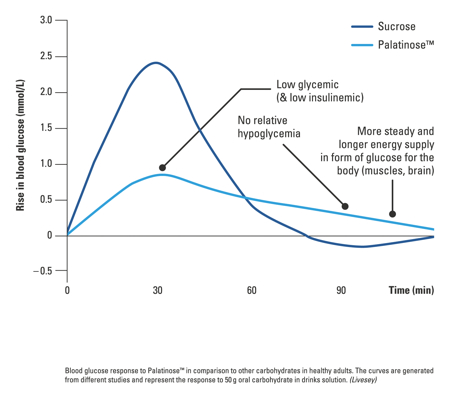Given that large amounts of high-glycaemic carbohydrates have been associated with long-term health risks and today’s consumer is both increasingly aware of the role that carbohydrates can play in terms of digestibility, caloric value and glycaemic response, and expects what they eat to contribute to their overall fitness — be it weight management or performance — demand for sugar replacers and slowly digestible products is on the rise.
Nutraceutical Business Review We know that carbohydrates with a low glycaemic index are good for us. Why is this?
Anke Sentko Carbohydrates should be the major source of energy for the body, as it is advised that other sources of energy intake, such as fat and protein, be avoided in excess. However, the quality of the carbohydrate matters. In this context, quality means how quickly or slowly a carbohydrate is digested and absorbed (Figure 1). Quick absorption is less desirable from a physiological point of view as it constantly triggers hormonal counter-regulations in an attempt to keep blood glucose levels in a normal range.
Longer-term, the elasticity of the system is placed under increased stress and the result can be impaired glucose tolerance, diabetes and a range of other health issues. Of course, many other factors play a role in longer-term illnesses, such as genetic disposition, whether the person is physically active or obese, for example. Choosing a lower glycaemic diet that leads to a lower profile of blood glucose and insulin on a daily basis may be a good preventive measure. This can be achieved by selecting carbohydrate-rich, yet low glycaemic options.

Figure 1: Blood glucose response to Palatinose in comparison with other carbohydrates in healthy adults (50g oral carbohydrate in solution)
There are several ways to lower the glycaemic properties of carbohydrate-based foods:
- Modification of the glucose supply using replacement carbohydrates that deliver the same amount of energy but in a different way; that is, choosing a low glycaemic, yet fully digestible, carbohydrate such as Palatinose (isomaltulose), instead of high glycaemic carbohydrates (such as glucose, sucrose, maltodextrins or the processed starch found in white bread or boiled potatoes).
- Reduction of glucose supply by replacement with less digestible ingredients that deliver fewer calories; that is, replacing high glycaemic carbohydrates with very low glycaemic polyols (isomalt) or non-glycaemic carbohydrates such as prebiotic fibres (oligofructose or inulin).
NBR What exactly is the glycaemic index and how do you measure it?
AS Key to healthy nutrition is a lower glycaemic blood glucose response. The Glycaemic Index (GI) is one of several tools that help to classify foods. The measurement of the GI is traditionally calculated from 10 people’s samples after overnight fasting. Subjects need to eat an amount of food that delivers 50g of available carbohydrates and then the blood glucose response is measured during a period of two hours. As a control, 50g of glucose, or white bread is eaten. Areas under the blood glucose response curves are then measured and used to calculate the food’s GI. The GI of a carbohydrate is deemed to be “high” if it is 70 or above, “medium” in the range between 56 and 69 and “low” if it is 55 or below.
NBR How do these carbohydrates differ regarding their ease of digestion and calorie content (that is, those with a low GI index compared with others with a high GI)?
AS Carbohydrates with a fast and high blood glucose response (such as glucose, sucrose, maltodextrins or processed starches) provide the full carbohydrate calories of 4kcal/g, combined with a high blood glucose and insulin profile. There is one unique fully available but slowly released sugar. This is called isomaltulose (Palatinose, BENEO). Palatinose provides the full carbohydrate energy (4kcal/g) but is released more slowly in the small intestine and thus provides a low glycaemic response and a low insulin profile.
All other approaches to reducing the blood glucose response are related to replacements with low or non-digestible carbohydrates
All other approaches to reducing the blood glucose response are related to replacements with low or non-digestible carbohydrates. These low or non-digestible replacers have the advantage of providing only approximately half the calories of fully available carbohydrates and they have no, or very low, blood glucose responses. As these ingredients are not digested in the small intestine, they reach the large intestine and are fermented there by the gut microflora. This process may lead to osmotic effects and gastrointestinal notice — subject to individual sensitivity. This physiological effect, however, can be seen as another advantage of the dietary fibre effect.
NBR Can you tell us about your functional carbohydrate ingredients: Isomalt and Palatinose? How did you develop them?
AS BENEO’s Palatinose is a disaccharide-type carbohydrate with unique physiological properties. It is a slow release carbohydrate that supplies the body with fully available carbohydrate energy in a more balanced way and for a longer period of time than other sugars. Being low glycaemic, it allows a more balanced supply of glucose energy and a related higher contribution of fat oxidation in energy metabolism, with potential longer-term benefits for glucose control, body composition and weight management. Also, it is the first tooth-friendly sugar.

People are beginning to understand that food and drink with low glycaemic blood glucose responses can promote well-being and support healthier ageing
Isomaltulose — the generic term — was discovered by Südzucker. It occurs naturally in small amounts of honey and sugar cane juice and, when produced for large-scale food applications, Palatinose is obtained from sucrose by enzymatic rearrangement. It has been on the European market since 2005. BENEO’s isomalt is the only sugar replacer made from beet sugar. It was discovered by Südzucker and developed and launched by Palatinit (a 100% subsidiary of Südzucker) in the 1970s. In 2007, Palatinit joined with Remy and Orafti to become BENEO. Isomalt has a sugar-like, mild sweet taste, is very low glycaemic, sugar-free, tooth-friendly and provides only half the calories of fully available carbohydrates. EFSA evaluated the low glycaemic and tooth-friendly characteristics of both Isomalt and Palatinose positively and the European Commission approved corresponding claims in the Health Claim regime.
NBR What are the applications of both Isomalt and Palatinose?
AS BENEO’s sugar replacer, Isomalt, is the world market leader in sugar replacement for sugar-free and tooth-friendly hard candies. Beyond that, it is ideal for chewing gum coating or centres and also serves as a sugar replacer in chocolate, cereals and baked goods. BENEO’s slow release carbohydrate, Palatinose, is ideal for sports nutrition because of its sustained energy supply and its contribution to improved fat oxidation. Overall, it perfectly suits all sports, functional and wellness foods or beverages. As the first tooth-friendly sugar, it also offers food producers the opportunity to widen the scope of tooth-friendly products from candy and gum to chocolate, beverages and more.
NBR What do you think has influenced the functional carbohydrate market? Where do you see the market heading?
The quality of different carbohydrates needs to be moved higher up the agenda
AS According to WHO, carbohydrates should make up a large part of the human diet (55–65%). However, the high prevalence of prediabetes, diabetes and obesity worldwide, in particular in those with Western-style diets, shows that the quality of different carbohydrates needs to be moved higher up the agenda. People are beginning to understand that food and drink with low glycaemic blood glucose responses can promote well-being and support healthier ageing. Food and drink producers are well aware of the need to offer products that promote nutritional benefits to meet this growing awareness, which is why BENEO supports the food industry with sound nutrition science, formulation advice as well as recent market insights.
NBR Where does BENEO see its future in the functional carbohydrate market? Do you have any other products in the pipeline?
AS BENEO is dedicated to R&D and will continue its research into the low glycaemic benefits of its ingredients in areas such as weight management and digestive health. With its portfolio of low glycaemic carbohydrates including Palatinose, ISOMALT and the prebiotic fibres Orafti inulin and Orafti oligofructose, BENEO is well set to offer solutions for balanced and healthy nutrition.





